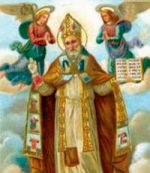The Threefold Miracle
by Zsolt Aradi
The visitor to Lourdes today finds himself in the presence of a threefold phenomenon of both the visible and invisible order. On the material level there is the fame of an unimportant town, which aroused the curiosity of believer and unbeliever. No one has to ask what Lourdes is; mention of this name immediately calls to mind the pilgrimages, the beautiful landscape and the thousands of sick, who year after year visit the shrine seeking relief and liberation from terrible diseases and pain. Thus Lourdes is famous for a second reason: it requires the imagination of a Dante to describe adequately the human suffering reflected on the faces of those thousands, who pray and hope. The throng, which in slow procession moves toward the grotto and to the spring of the healing water, is perhaps one of the most deeply affecting sights in the world.
But the spiritual fame of Lourdes is its greatest claim to glory. And this glory is again threefold because Lourdes enfolds three miracles: the miracle of the apparition of the most Blessed Virgin, the miracle of the sanctity of Bernadette Soubirous who conveyed to the world the message of the Queen of Heaven, and finally the never ceasing miracles, material and spiritual, which have taken place in Lourdes ever since the first apparition of the beautiful Lady at the grotto called Massabielle.
The grotto of Massabielle and its miraculous spring, beside which the two Basilicas now stand, draws year by year millions of pilgrims from all parts of the world. This is the grotto where Our Lady appeared eighteen times to Bernadette Soubirous, beginning on a chilly February day in the year 1858. Before Lourdes attained its threefold fame and threefold glory, the city had no prominence among its sister cities in France. Insignificant, though inhabited by a people deeply rooted in the history of the country and the region, the city was totally unaware and unprepared for the world-shaking happenings for which it was selected by the Divine Will. This Divine Will chose one of the ugliest quarters of Lourdes, and from its inhabitants the poorest of the poor. The Soubirous family lived in the miserable cell of a former prison, because Francis Soubirous, a day laborer, could hardly earn the money to sustain his family. It has been noted that one of the Soubirous children was once seen eating the wax dripping from the candles in a church to appease his hunger. And Francis Soubirous was accused of having stolen a sack of flour, though the charge was never substantiated or proven.
The grotto of Massabielle was a deserted wild spot where all day the swine would stray, a filthy cavern where sometimes the high water of the river Gave washed up the bones of beasts, a most wretched place, sometimes filled with snakes and rubble. This Massabielle was chosen by the Holy Virgin as the place of her appearance to Bernadette Soubirous, the fourteen-year-old, hard-working, normal daughter of the day laborer. This filthy grotto and this poor girl have been elevated to the highest possible peaks of spiritual fame. While Bernadette's parents worked she looked after the home and her sisters and brothers, and went out every day to gather wood for the fire. It was on February II, 1858, when Bernadette with her little sister and a friend were going to gather fagots on the banks of the Gave near the grotto Massabielle, that suddenly Bernadette was drawn toward the grotto which at that moment was filled with a bright cloud. The girl looked toward it and saw a beautiful young woman, who smiled at her. ...
After this Our Lady appeared seventeen times to Bernadette, the last time on July 16, 1858. The first of the threefold miracles of Lourdes, the apparition of Our Lady, was not generally accepted at the beginning. An incredulous world decried what was called the outbreak of superstitious hysteria and finally the grotto was closed. It took time to convince Napoleon III, Emperor of France, to order its reopening. When Bernadette conveyed the first message of the "beautiful Lady" to the dean of Lourdes, the priest threatened Bernadette that if she dared to return again with any message he would chase her out with a broom. It was ten years before the Church confirmed that these were true apparitions of the Blessed Virgin.
Dramatic developments followed: discussion upon discussion, attack upon attack, in an epoch when the world seemed to forget that beyond the realities of progress and everyday life there is a supernatural realm, the realm of the spirit, where God reigns supreme. But slowly many ardent adversaries had to bow their heads before the mass of irrefutable evidence. Franz Werfel, the great Austrian writer who was of the Jewish faith, wrote in 1941 of this evidence: "…what is true, what is invented? My answer is this: all the memorable happenings . . . took place in the world of reality. Since their beginning dates back no longer than eighty years there beats upon them the bright light of modern history, and their truth has been confirmed by friend and foe and by cool observers through faithful testimonies . . ."
The apparition of the Blessed Virgin could not have been more strongly emphasized than through the elevation to sainthood of the maiden who was the only one to see the Virgin. But this elevation to sainthood was possible only because Bernadette lived the life of a saint. The second miracle of Lourdes is Bernadette herself. The Blessed Virgin chose this innocent creature as her instrument and placed in the mouth of this girl the summons to penitence, to prayer for all sinners of the whole world. After the finding of the spring, and after the eighteenth apparition Bernadette's practical task seemed at an end. Her own life, which continued in the austere Convent of the Sisters of Charity of Nevers, was another evidence of miraculous nature. Bernadette always remained an unspoiled, simple, balanced human being, the obedient servant. The beautiful Lady did not promise her happiness on this earth. And Bernadette later on bore another sign of being chosen, for while the fame of Lourdes increased from day to day she was subjected to almost superhuman afflictions. Stricken with tuberculosis of the bone her life faded away in obscurity. She refused to be taken to the miraculous well: "The spring is not for me…." Bernadette died in 1879 at the age of 35. She was beatified in 1925 and canonized in 1933. The decay, which befalls every human body after death, did not touch hers. Bernadette's uncorrupted body lies in the Convent of the Sisters of Charity, Nevers, France.
The grotto was visited by many people from the very first day after the apparition. From the rock the water continued to flow more and more abundantly and miraculous cures took place immediately. To date the miraculous cures performed at Lourdes are innumerable. Millions have visited the shrine and other millions all over the world have recourse to Our Lady, asking aid and intercession in their physical and spiritual ills. Once Bernadette was asked whether she knew what a sinner is. "A sinner is one who loves evil," answered the little girl chosen by the Mother of God. The message of Lourdes to mankind, to every human being, whatever his creed or belief, is the opposite of sin: Penance and Love. The Queen of Heaven's intercession created one of the most powerful centers of real Love in Lourdes. Love of God and of the neighbor who is a sufferer, a sinner as we all are. And mankind can take this message to heart because all the happenings of Lourdes are still taking place before our own eyes.
This item 3048 digitally provided courtesy of CatholicCulture.org






